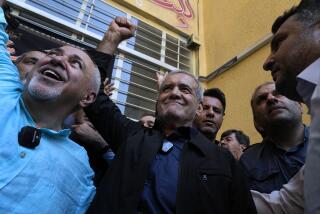Post-Revolution Boom for Iranian Yellow Pages : Immigrants in the Southland Discovering It’s Convenient to Find It in Farsi
- Share via
VAN NUYS — It’s taking fingers longer every year to walk through the Iranian Yellow Pages.
Eight years ago, Sohrab Rostamian and Bijan Khalili, who fled their homeland amid Iran’s revolutionary chaos in the late 1970s, published a 96-page telephone directory of businesses owned by the growing number of Iranian refugees in Southern California.
This year, the Iranian Yellow Pages is 848 pages long, listing about 1,600 businesses and professionals. The number of Iranian dentists, for example, that are listed in the book has climbed from six to 91. Rostamian and Khalili have set up a 411-like information service to give callers telephone numbers of Iranian businesses in their native Farsi language.
The reason for the growth of Ketab Corp., the Van Nuys parent company the two men own and run, is that Southern California, particularly the West San Fernando Valley, has become home to the largest concentration of Iranians in the United States. Most fled Iran in the wake of the 1979 revolution led by the Ayatollah Ruhollah Khomeini, who died recently. As many as 300,000 Iranians are believed to be living in Southern California, including some 30,000 Iranian Jews such as Rostamian and Khalili.
A large number of the Iranians in the United States came from the nation’s elite group of professionals such as doctors, lawyers and engineers. Some have established large, well-known businesses. The Bijan boutiques in Beverly Hills and New York were founded by Iranian-born designer Bijan Pakzad. Adrays, a chain of discount electronics stores, was started by Iranian Masud Hakim and two partners. Iran-born developer Kambiz Hemkat is building the 22-story Center West tower in Westwood.
Most of Rostamian’s and Khalili’s advertisers in the 1989 Iranian Yellow Pages paid $650 a year for a full-page ad. Businesses also are listed in a computer database of numbers given to people who call the information line. Some 34,000 copies of the yellow pages are distributed free and are used by nearly 200,000 Iranians, the partners estimated.
Most information in the Iranian Yellow Pages is written in Farsi, with a small amount of English scattered throughout. Pages are numbered from right to left because that is how Iranian books are numbered.
A standard yellow pages logo, showing two fingers walking across the pages of a book, adorns the front of the book as well as Ketab’s headquarters building on Van Nuys Boulevard. The main difference is that the fingers are walking on pages of green, white and red, the colors of the Iranian flag.
Most of the advertisers are professionals or small-to-medium-sized businesses. Beverly Hills urologist James Elist, who moved to the United States from Iran in 1976, said that two to three patients a week locate him through the Iranian Yellow Pages. Some large firms, such as brokerage houses and insurance companies, advertise in the directory, typically featuring Iranian employees in their ads.
Ketab Corp. is grossing about $1 million a year, compared to about $80,000 in 1981. Ketab (which means “book” in Farsi) has a direct-mail service to Iranians. Two years ago, the information line was started (818-908-0808, because “08” was once the information number in Iran, equivalent to the U.S. use of 411.)
Ketab also operates a bookstore in Westwood for Iranians. (The bookstore does not sell Salman Rushdie’s “The Satanic Verses,” the novel that inspired Khomeini to call for the death of Rushdie. Rostamian and Khalili say they don’t want trouble.)
Rostamian, 38, an agricultural engineer by training, and Khalili, 38, a civil engineer, are both natives of Tehran and became friends while studying during the late 1960s at Pahlavi University, now the University of Shiraz, about 500 miles south of Tehran.
Fearing that trouble was coming, Rostamian left Iran for Europe in 1978 just before the revolution, arriving in Los Angeles in 1979. Khalili left Iran in 1980, traveling first to Switzerland and then to Los Angeles, where he arrived on Thanksgiving Day.
Growth in the number of Iranians in Southern California is one obvious reason for growth in Rostamian’s and Khalili’s business.
But Rostamian has another interesting theory. He said many Iranian exiles thought Khomeini’s regime would only last a year or two and, sensing they would be returning home soon, did not establish roots.
“Many people didn’t even unpack the first year,” Rostamian said.
When it became clear that they were wrong, he said, people began settling down and starting businesses and establishing practices that have started to thrive the past few years.
Smaller Iranian Yellow Pages are published in Northern California, New York, Houston and Atlanta. The Southern California version includes listings from those areas.
Directories such as the Iranian Yellow Pages are part of a growing trend in yellow pages--a generic name used widely--that are being published for target ethnic groups. There are about 80 second-language, or non-English, yellow pages across the country. Yellow pages featuring Vietnamese-owned businesses have been published in Northern and Southern California. Direct Language Publishing in San Francisco, the largest second-language yellow pages company, publishes five Asian-language yellow pages in Northern California and 15 Spanish yellow pages throughout California and Arizona.
One reason the publications are often successful is that immigrants often want to do business with other people from their home countries.
“When you have big pockets of ethnic groups it makes sense. There have been quite a few attempts to demographically segment the market,” said Larry Small, vice president of marketing for the Yellow Pages Publishers Assn. in Troy, Mich.
FO Farsi, the language of Iran, dominates the Iranian Yellow Pages.
More to Read
Inside the business of entertainment
The Wide Shot brings you news, analysis and insights on everything from streaming wars to production — and what it all means for the future.
You may occasionally receive promotional content from the Los Angeles Times.










